Preface
byPreface opens with a candid reflection from the author, who speaks not just as a playwright, but as a participant in a broader creative movement. Rather than replicating the story of The Bellows-Mender, which only faintly lingers in his memory, he reshapes the premise into something more purposeful and emotionally nuanced. The narrative no longer serves as mere imitation—it becomes a vessel for exploring deeper themes through wholly original characters. By situating the story during the era of the French Republic, the author finds a fertile setting that blends romantic turmoil with political change. This choice lends credibility to Claude Melnotte’s social aspirations and inner conflicts. The post-revolutionary context allows for blurred class lines and passionate ambition to coexist, creating a world where emotional intensity mirrors societal upheaval.
At its core, the play is more than artistic expression—it is an act of support. The author aligns himself with Mr. Macready, the distinguished actor-manager of Covent Garden, who had undertaken a bold experiment in restoring the nobler form of drama. Producing The Lady of Lyons was not simply a personal milestone but a collaborative gesture aimed at elevating the theatrical arts. In choosing to offer this work to the stage, the author actively supports a vision that resists mediocrity and commercialism. Macready’s efforts to steer the theater toward more elevated, intellectually rich content are echoed in the playwright’s own structural and thematic choices. The drama is built with care, not only to entertain, but to carry weight—each act arranged to blend feeling, structure, and spectacle.
The preface also serves as a personal challenge addressed to past criticism. After The Duchess de la Valliere was received with measured praise, questions had surfaced about the author’s understanding of stage mechanics. Here, he takes the opportunity to answer those doubts not with explanation, but with refinement. By emphasizing construction, he acknowledges that a play must do more than tell a story—it must live through timing, contrast, and character arcs that rise and fall with dramatic logic. He aims to prove that he has mastered not only the flow of language but the orchestration of emotion and conflict onstage. The result is a narrative that doesn’t simply unfold—it tightens, releases, and builds toward revelation with calculated effect.
What’s especially valuable in this reflection is the understanding that storytelling is both craft and service. The author does not write in a vacuum. He writes with awareness—of the stage, of the audience, and of his peers. The play becomes a response to a specific cultural moment, where artistry is under threat from superficial spectacle. By offering a work that blends accessible emotion with carefully designed structure, he aims to remind both viewers and critics of the stage’s potential as a moral and imaginative space. His allegiance lies not only with Macready but with the values of dramatic tradition—of character growth, poetic justice, and redemption shaped by inner struggle.
This preface also subtly invites the reader to judge the play on its merits, not through the lens of comparison, but through the honesty of its intention. The author does not claim to have produced perfection. Instead, he claims effort—an intentional focus on structure, effect, and human emotion. He acknowledges how deeply theater relies on timing, actor presence, and audience reception, which are often invisible to the reader of a script. The play’s real power comes when it is inhabited, performed, and felt. That, perhaps, is the deeper message of the preface: the drama only breathes when others believe in its rhythm.
Through this introduction, the reader is drawn into more than a fictional world—they are brought into the space of artistic decision-making. We are reminded that behind every performance lies a network of choices, sacrifices, and intentions. The author’s vulnerability in revealing his motivation does not weaken the work—it strengthens its purpose. The Lady of Lyons becomes more than a story of love and pride; it becomes a declaration of belief in the theater as a transformative art form. This preface, far from being a mere note of origin, functions as a map of the values that guide the playwright’s hand and the emotions he hopes to evoke. In that light, every character and conflict becomes a reflection of the artistic questions raised here—what is worth pursuing, and at what cost?

